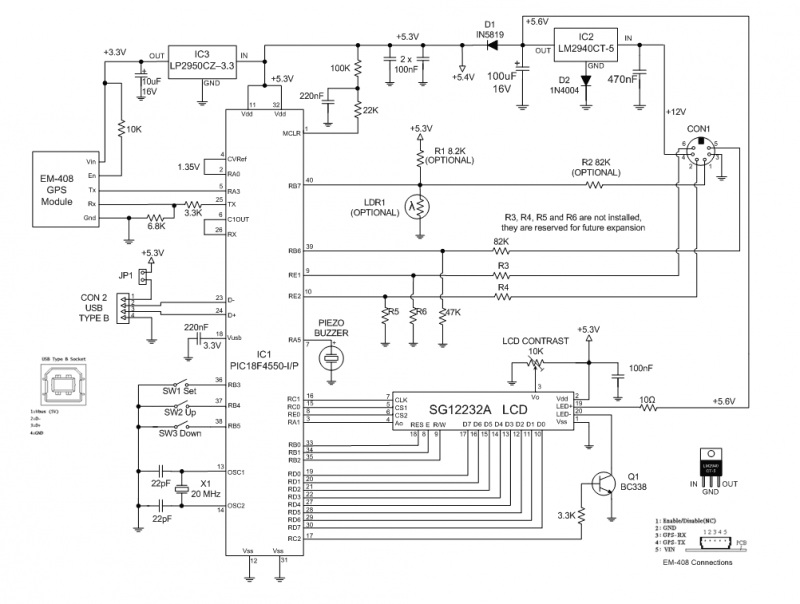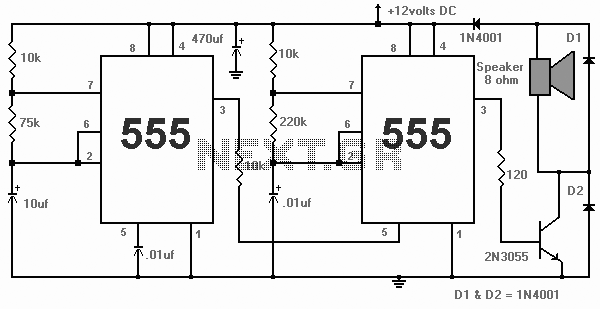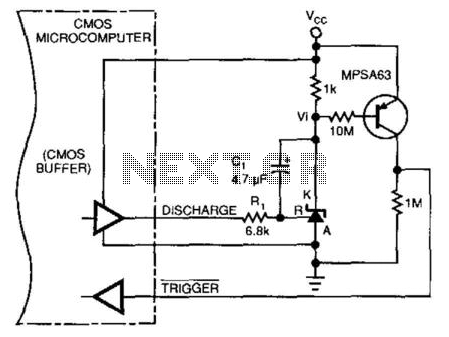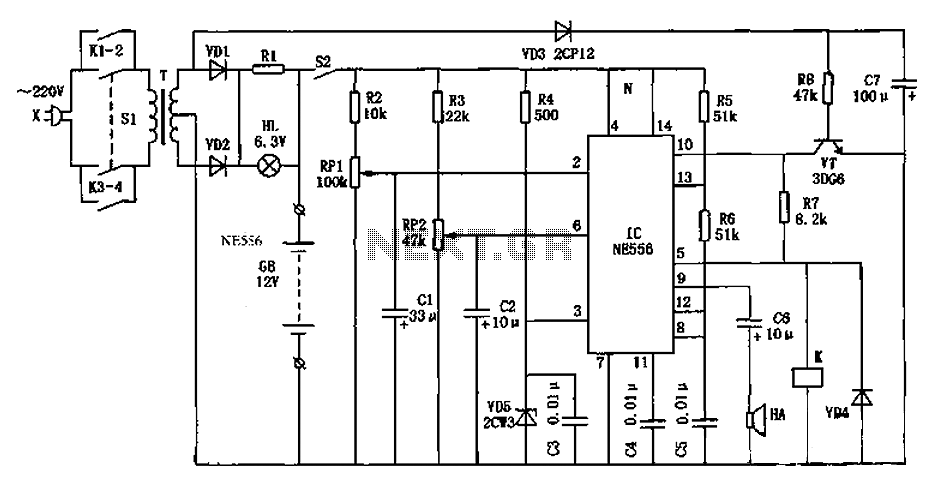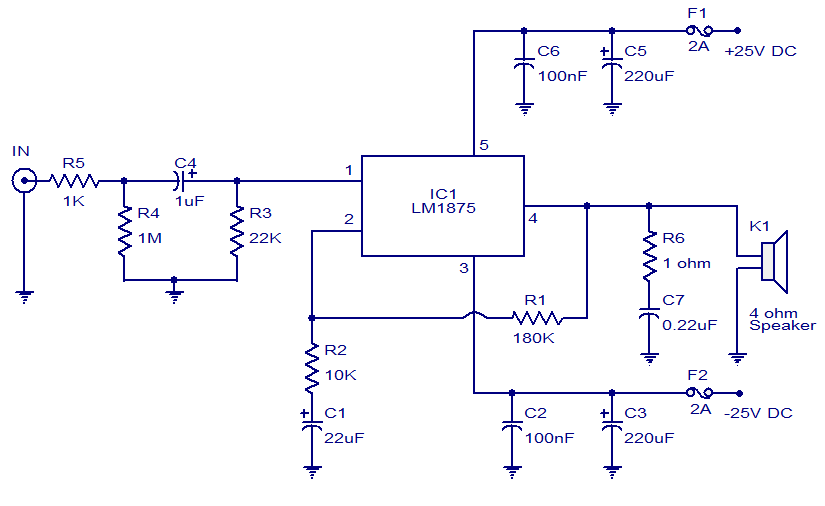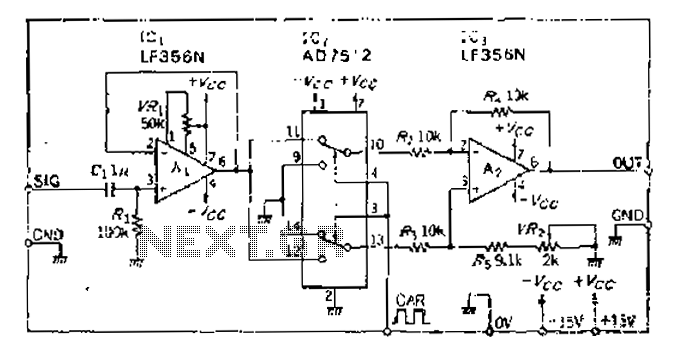
Car battery charger
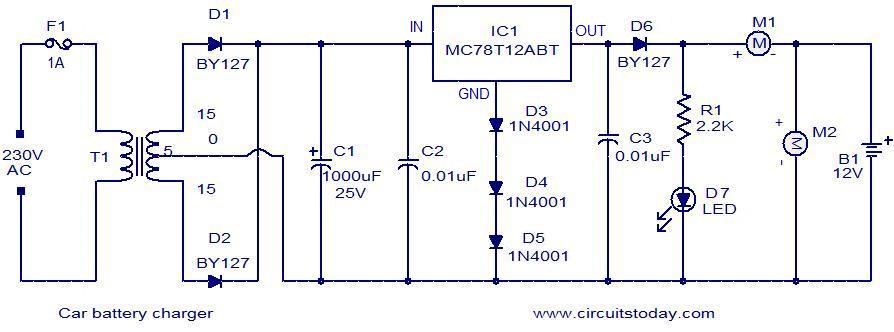
Below is a simple circuit designed for charging car batteries. This circuit includes the capability to monitor both the charging current and voltage. It utilizes the IC MC78T12ABT from Freescale, which is essentially a 7812 in a TO-3 package with a 3A capacity. The transformer T1 reduces the mains voltage, while diodes D1 and D2 perform rectification. Capacitor C1 is responsible for filtering, and C2 serves as a decoupling capacitor. The ground terminal of IC1 is elevated to 2.1V using diodes D3, D4, and D5, resulting in an output from IC1 of a regulated 14.1V (12V + 2.1V). The battery is charged through diode D6, which prevents reverse current flow from the battery to the charging circuit when mains power is unavailable. Meter M1 indicates the charging current, while M2 displays the charging voltage.
The circuit operates by first stepping down the AC mains voltage using transformer T1, which is critical for safe operation. The output from the transformer is then rectified by diodes D1 and D2, converting the AC voltage to DC. This DC voltage is filtered by capacitor C1 to smooth out any ripple, ensuring a stable voltage supply for the rest of the circuit. Capacitor C2 acts as a decoupling capacitor, helping to stabilize the voltage supplied to the IC and preventing fluctuations that could affect performance.
The MC78T12ABT voltage regulator is pivotal in maintaining a consistent output voltage. By elevating the ground terminal to 2.1V with the help of diodes D3, D4, and D5, the output voltage is adjusted to a regulated 14.1V, which is optimal for charging car batteries. This configuration allows for efficient battery charging while providing the necessary safeguards against reverse current flow through diode D6.
The inclusion of meters M1 and M2 enhances the functionality of the circuit by providing real-time monitoring of the charging conditions. Meter M1 displays the charging current, allowing users to assess the charging rate, while meter M2 shows the charging voltage, ensuring that the battery is receiving the correct voltage level throughout the charging process. This circuit is not only straightforward in design but also effective in its application for charging car batteries safely and efficiently.Given below, is a very simple circuit that can be used for charging car batteries. In this circuit there is facility for monitoring the charging current and voltage. The circuit is based on the IC MC78T12ABT from Freescale. The IC is nothing but a 7812 in TO-3 package with 3A capacity. The transformer T1 steps down the mains voltage and diodes D1&D 2 does the job of rectification. Capacitor C1 does the filtering and C2 acts as a decoupling capacitor. The ground terminal of IC1 is lifted to 2. 1V using the diodes D3, D4 and D5. So the output from the IC1 will be a regulated 14. 1V (12+2. 1). The battery is charged via diode D6. The D6 blocks reverse flow of current from battery to charging circuit when the mains power is not available. Meter M1 shows the charging current and M2 shows the charging voltage. 🔗 External reference
The circuit operates by first stepping down the AC mains voltage using transformer T1, which is critical for safe operation. The output from the transformer is then rectified by diodes D1 and D2, converting the AC voltage to DC. This DC voltage is filtered by capacitor C1 to smooth out any ripple, ensuring a stable voltage supply for the rest of the circuit. Capacitor C2 acts as a decoupling capacitor, helping to stabilize the voltage supplied to the IC and preventing fluctuations that could affect performance.
The MC78T12ABT voltage regulator is pivotal in maintaining a consistent output voltage. By elevating the ground terminal to 2.1V with the help of diodes D3, D4, and D5, the output voltage is adjusted to a regulated 14.1V, which is optimal for charging car batteries. This configuration allows for efficient battery charging while providing the necessary safeguards against reverse current flow through diode D6.
The inclusion of meters M1 and M2 enhances the functionality of the circuit by providing real-time monitoring of the charging conditions. Meter M1 displays the charging current, allowing users to assess the charging rate, while meter M2 shows the charging voltage, ensuring that the battery is receiving the correct voltage level throughout the charging process. This circuit is not only straightforward in design but also effective in its application for charging car batteries safely and efficiently.Given below, is a very simple circuit that can be used for charging car batteries. In this circuit there is facility for monitoring the charging current and voltage. The circuit is based on the IC MC78T12ABT from Freescale. The IC is nothing but a 7812 in TO-3 package with 3A capacity. The transformer T1 steps down the mains voltage and diodes D1&D 2 does the job of rectification. Capacitor C1 does the filtering and C2 acts as a decoupling capacitor. The ground terminal of IC1 is lifted to 2. 1V using the diodes D3, D4 and D5. So the output from the IC1 will be a regulated 14. 1V (12+2. 1). The battery is charged via diode D6. The D6 blocks reverse flow of current from battery to charging circuit when the mains power is not available. Meter M1 shows the charging current and M2 shows the charging voltage. 🔗 External reference
